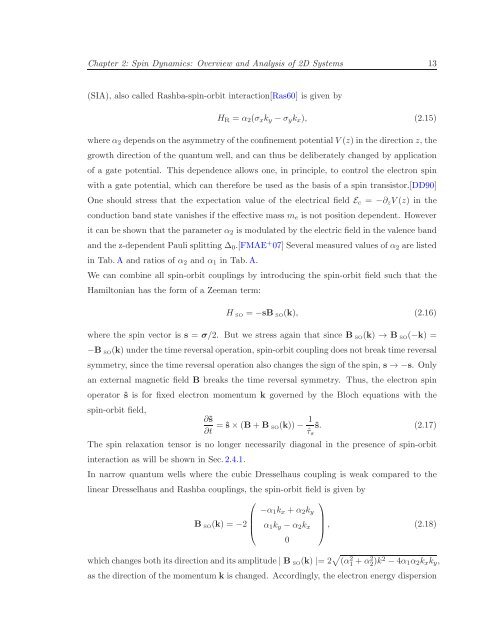Itinerant Spin Dynamics in Structures of ... - Jacobs University
Itinerant Spin Dynamics in Structures of ... - Jacobs University
Itinerant Spin Dynamics in Structures of ... - Jacobs University
Create successful ePaper yourself
Turn your PDF publications into a flip-book with our unique Google optimized e-Paper software.
Chapter 2: <strong>Sp<strong>in</strong></strong> <strong>Dynamics</strong>: Overview and Analysis <strong>of</strong> 2D Systems 13<br />
(SIA), also called Rashba-sp<strong>in</strong>-orbit <strong>in</strong>teraction[Ras60] is given by<br />
H R = α 2 (σ x k y −σ y k x ), (2.15)<br />
whereα 2 dependsontheasymmetry<strong>of</strong>theconf<strong>in</strong>ementpotentialV(z)<strong>in</strong>thedirectionz, the<br />
growth direction <strong>of</strong> the quantum well, and can thus be deliberately changed by application<br />
<strong>of</strong> a gate potential. This dependence allows one, <strong>in</strong> pr<strong>in</strong>ciple, to control the electron sp<strong>in</strong><br />
with a gate potential, which can therefore be used as the basis <strong>of</strong> a sp<strong>in</strong> transistor.[DD90]<br />
One should stress that the expectation value <strong>of</strong> the electrical field E c = −∂ z V(z) <strong>in</strong> the<br />
conduction band state vanishes if the effective mass m e is not position dependent. However<br />
it can be shown that the parameter α 2 is modulated by the electric field <strong>in</strong> the valence band<br />
and the z-dependent Pauli splitt<strong>in</strong>g ∆ 0 .[FMAE + 07] Several measured values <strong>of</strong> α 2 are listed<br />
<strong>in</strong> Tab.A and ratios <strong>of</strong> α 2 and α 1 <strong>in</strong> Tab.A.<br />
We can comb<strong>in</strong>e all sp<strong>in</strong>-orbit coupl<strong>in</strong>gs by <strong>in</strong>troduc<strong>in</strong>g the sp<strong>in</strong>-orbit field such that the<br />
Hamiltonian has the form <strong>of</strong> a Zeeman term:<br />
H SO = −sB SO (k), (2.16)<br />
where the sp<strong>in</strong> vector is s = σ/2. But we stress aga<strong>in</strong> that s<strong>in</strong>ce B SO (k) → B SO (−k) =<br />
−B SO (k)underthetimereversaloperation, sp<strong>in</strong>-orbitcoupl<strong>in</strong>gdoesnotbreaktimereversal<br />
symmetry, s<strong>in</strong>ce the time reversal operation also changes the sign <strong>of</strong> the sp<strong>in</strong>, s → −s. Only<br />
an external magnetic field B breaks the time reversal symmetry. Thus, the electron sp<strong>in</strong><br />
operator ŝ is for fixed electron momentum k governed by the Bloch equations with the<br />
sp<strong>in</strong>-orbit field,<br />
∂ŝ<br />
∂t = ŝ×(B+B SO(k))− 1ˆτ s<br />
ŝ. (2.17)<br />
The sp<strong>in</strong> relaxation tensor is no longer necessarily diagonal <strong>in</strong> the presence <strong>of</strong> sp<strong>in</strong>-orbit<br />
<strong>in</strong>teraction as will be shown <strong>in</strong> Sec.2.4.1.<br />
In narrow quantum wells where the cubic Dresselhaus coupl<strong>in</strong>g is weak compared to the<br />
l<strong>in</strong>ear Dresselhaus and Rashba coupl<strong>in</strong>gs, the sp<strong>in</strong>-orbit field is given by<br />
⎛ ⎞<br />
−α 1 k x +α 2 k y<br />
B SO (k) = −2⎜<br />
⎝ α 1 k y −α 2 k x<br />
⎟<br />
⎠ , (2.18)<br />
0<br />
whichchangesbothitsdirectionanditsamplitude| B SO (k) |= 2 √ (α 2 1 +α2 2 )k2 −4α 1 α 2 k x k y ,<br />
as the direction <strong>of</strong> the momentum k is changed. Accord<strong>in</strong>gly, the electron energy dispersion
















